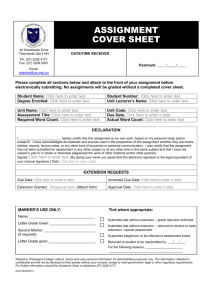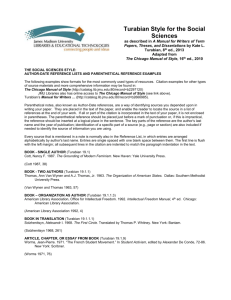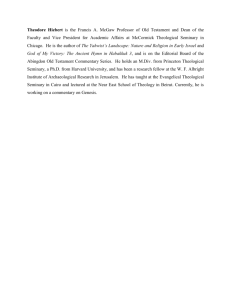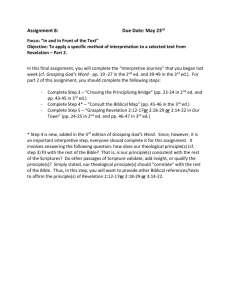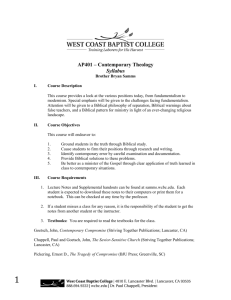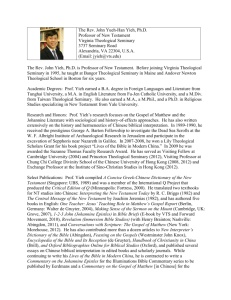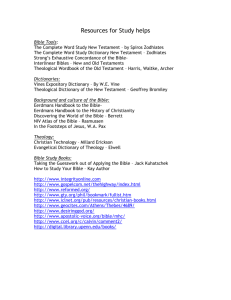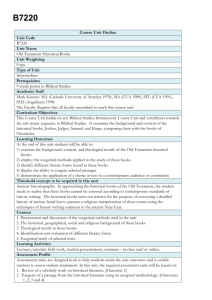Turabian Supplement - Dallas Theological Seminary
advertisement
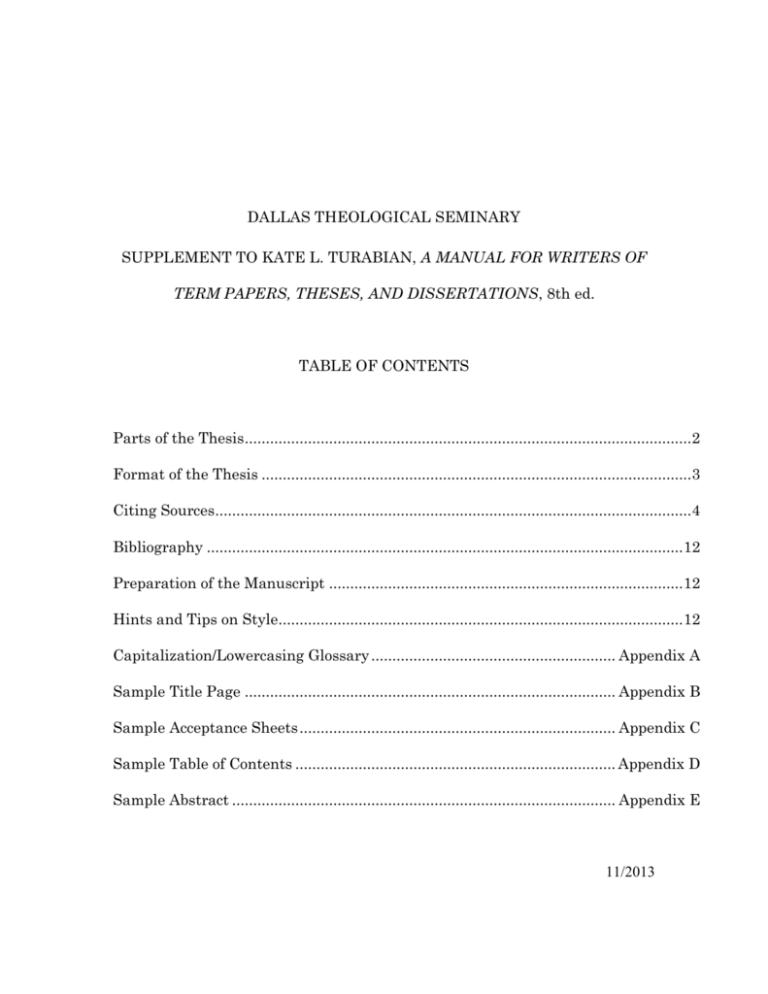
DALLAS THEOLOGICAL SEMINARY SUPPLEMENT TO KATE L. TURABIAN, A MANUAL FOR WRITERS OF TERM PAPERS, THESES, AND DISSERTATIONS, 8th ed. TABLE OF CONTENTS Parts of the Thesis ..........................................................................................................2 Format of the Thesis ......................................................................................................3 Citing Sources.................................................................................................................4 Bibliography ................................................................................................................. 12 Preparation of the Manuscript .................................................................................... 12 Hints and Tips on Style................................................................................................ 12 Capitalization/Lowercasing Glossary .......................................................... Appendix A Sample Title Page ........................................................................................ Appendix B Sample Acceptance Sheets ........................................................................... Appendix C Sample Table of Contents ............................................................................ Appendix D Sample Abstract ........................................................................................... Appendix E 11/2013 2 SUPPLEMENT TO KATE L. TURABIAN, A MANUAL FOR WRITERS OF RESEARCHS PAPERS, THESES AND DISSERTATIONS, 8TH ED. The purpose of this supplement is to point out preferences adopted by the DTS Thesis Style Committee where Turabian gives options, and to add information peculiar to DTS research projects not otherwise addressed in Turabian. Turabian is very thorough in its treatment of most issues involving form and style and is actually rather easy to use if one takes the time to read the fifteenth, sixteenth, and seventeenth chapters and consults the very complete Index of topics in the back. Turabian, along with this supplement, should address most of the questions students will have regarding form and style relative to writing research papers, theses, and dissertations. In addition to following this supplement, the student is encouraged to use the research paper and thesis templates that are available for download from http://library.dts.edu/Pages/RM/Write/ . With the use of these tools, many of the style requirements specified here (e.g., margins, spacing) are fulfilled automatically. Parts of the Thesis or Dissertation Order of the Front Matter Change the order of the “Front Matter” (Turabian A.2.1) for a thesis or dissertation as follows, omitting parts that are not applicable. Blank Page Title Page Acceptance Sheet Abstract Contents Illustrations Tables Abbreviations Acknowledgements Preface Title Page See Appendix B for an example. The author’s full name should be used on the title page. Examples of acceptable forms are Lewis Sperry Chafer, John F. Walvoord, and S. Lewis Johnson Jr. The author’s name must not be concealed in any fashion and pseudonyms must not be used. Greek and Hebrew words should be transliterated in the title. The date on the title page of theses and dissertations should be the month of graduation and the year (without a comma between them), not the date when the final draft was submitted. However, if the thesis is written after graduation, use the date of writing. 3 Acceptance Sheet See Appendix C for sample acceptance sheets for theses and dissertations. Abstract Abstracts are required for all theses and dissertations. This page should have the heading “ABSTRACT” and include the full title of the dissertation, the author’s name, and the full names of the readers, with either their first name and middle initial or first initial and middle name. Do not include personal titles such as “Dr.” The abstract should function as a “stand alone” document which includes a statement of the problem, a brief exposition of the main lines of argument, and the conclusion. The abstract must not exceed 350 words. See Appendix E for an example. Contents For the table of contents, see the instructions in Turabian A.2.1.6 and the example in Appendix D of this supplement. Use headline style of capitalization (Turabian 22.3.1). Parts are not necessary. Abbreviations Theses and dissertations (but not research papers) should include a complete list of the abbreviations used. Follow the example on Turabian, p. 387. Format of the Thesis All of the formatting conventions adopted by DTS have been saved as settings in the thesis and term paper templates. The student is responsible to adhere to the following conventions even if those tools are not used. Margins Leave a margin of one inch on the top, bottom, and right side and one and a half inch (for binding purposes) on the left side for all theses and dissertations. Leave a margin of one inch on all sides for research papers. Typeface Use twelve-point type for the body of the text and ten-point type for footnotes. 4 Spacing and Indentation All theses should be double-spaced. Indent the beginning of paragraphs and footnotes ¾ inches and block quotations ½ inches. Paragraph indention for block quotation should be another ¼ inches if you are quoting from the beginning of the paragraph. Pagination All pages within the front matter should be numbered, except the title page (although it is counted as page i). The page numbers for front matter sections should be lowercase, Roman numerals that are centered at the bottom of the page. For the body of the paper, use Arabic numerals and place them at the top right-hand side for pages that do not begin a new chapter. For pages that do begin a new chapter, center the page number at the bottom. Subheadings With regard to subheadings as discussed in Turabian A.2.2.4, use the following options: Level 1 Level 2 Level 3 Level 4 Level 5 Centered, boldface Centered, roman type Flush left, boldface Flush left, roman type Run in at beginning of paragraph, boldface All five levels may not be necessary for most research papers, and any combination of levels may be used as long as they adhere to the order above. Citing Sources Plagiarism Please read Turabian 4.2.3, 7.9 and section 1.16.3 of the Student Handbook carefully. Quotations Note the distinction between block quotations and run-in quotations in Turabian 25.2.1-2. Specifically note that a block quotation must be five lines or more and single-spaced. Biblical Citations Spell out the name of biblical books when they are referred to in their entirety. To cite a specific biblical passage within the text or notes, follow the guidelines given in Turabian 17.5.2, but use the following abbreviations instead of the ones given in Turabian 24.6.1. 5 Old Testament Gen Exod Lev Num Deut Josh Judg Ruth 1-2 Sam 1-2 Kgs 1-2 Chr Ezra Neh Esth Job Ps/Pss Prov Eccl (or Qoh) Genesis Exodus Leviticus Numbers Deuteronomy Joshua Judges Ruth 1-2 Samuel 1-2 Kings 1-2 Chronicles Ezra Nehemiah Esther Job Psalms Proverbs Ecclesiastes (or Qoheleth) Song or (Cant) Isa Jer Lam Ezek Dan Hos Joel Amos Obad Jonah Mic Nah Hab Zeph Hag Zech Mal Song of Songs (or Canticles) Isaiah Jeremiah Lamentations Ezekiel Daniel Hosea Joel Amos Obadiah Jonah Micah Nahum Habakkuk Zephaniah Haggai Zechariah Malachi Matthew Mark Luke John Acts Romans 1-2 Corinthians Galatians Ephesians Philippians Colossians 1-2 Thess 1-2 Tim Titus Phlm Heb Jas 1-2 Pet 1-2-3 John Jude Rev 1-2 Thessalonians 1-2 Timothy Titus Philemon Hebrews James 1-2 Peter 1-2-3 John Jude Revelation Jdt 1-2 Macc 3-4 Macc Pr Man Ps 151 Sir Tob Wis Judith 1-2 Maccabees 3-4 Maccabees Prayer of Manasseh Psalm 151 Sirach/Ecclesiasticus Tobit Wisdom of Solomon New Testament Matt Mark Luke John Acts Rom 1-2 Cor Gal Eph Phil Col Apocrypha and Septuagint Bar Add Dan Pr Azar Bel Sg three Sus 1-2 Esd Add Esth Ep Jer Baruch Additions to Daniel Prayer of Azariah Bel and the Dragon Song of the Three Young Men Susanna 1-2 Esdras Additions to Esther Epistle of Jeremiah 6 Footnotes Footnotes are required in all theses and dissertations and are recommended for all research and term papers. Endnotes may be used on research and term papers at the discretion of the professor. See Turabian 16.3.4 for properly formatting footnotes, but note that DTS requires superscripts for note numbers rather than regular text. Pay special attention to Turabian 16.3.3, which states that footnotes must start over with 1 for each new chapter. Subsequent notes within the same chapter should be shortened by the author-title method; see Turabian 16.4.1 for examples. Note, however, that the first reference to a work within a new chapter should be a full reference. Turabian chapter 16 explains the general principles to be followed for the notebibliography citation style, while chapter 17 provides specific examples. Although Turabian allows but does not require the inclusion of series information in footnotes and bibliographic entries, the series title and volume number (if available) are important and should be included; the series editor’s name is optional, however. Special and problematic examples of footnotes and their corresponding bibliographic entries are provided below. Abbreviations within Footnotes It is common in biblical and theological studies for well-known journal and reference titles to be abbreviated in footnotes, contrary to Turabian 17.2.3. Abbreviated titles must be included in a list of abbreviations, however, and the full title must be included in the bibliography. A list of standard abbreviations for biblical and theological studies can be found in pages 89-153 of the SBL Handbook of Style (Peabody, MA: Hendrickson Publishers, 1999). Special Types of References Article Citations Contrary to the example provided in Turabian 17.2.4, it is not necessary to include a month or season when citing a journal article; issue numbers may be included for journals that are paginated consecutively through the issues of a volume. N: Robert B. Chisholm Jr., “Identity Crisis: Assessing Samson’s Birth and Career,” Bibliotheca Sacra 166 (2009): 148. B: Chisholm, Robert B., Jr. “Identity Crisis: Assessing Samson’s Birth and Career.” Bibliotheca Sacra 166 (2009): 147-62. 7 Greek and Hebrew Words from Lexica References concerning Greek and Hebrew words from lexica such as BDB, BDAG, TDOT and TDNT are special cases and should be treated as the examples below. If the article is unsigned, begin the citation with the editor’s name, followed by the bibliographic information and the page reference. N: Walter Bauer, A Greek-English Lexicon of the New Testament and Other Early Christian Literature, rev. and ed. Frederick W. Danker, 3rd ed. (Chicago: University of Chicago Press, 2000), 576-79. Abbreviated titles are allowed as long as the full title is included in a list of abbreviations. According to that option, the previous note would be: N: BDAG, 576-79. The bibliographic entry should refer only to the work as a whole and not the specific entry, and the title should not be abbreviated. B: Bauer, Walter. A Greek-English Lexicon of the New Testament and Other Early Christian Literature. Revised and edited by Frederick W. Danker. 3rd ed. Chicago: University of Chicago Press, 2000. If the article is signed, begin the citation with the author’s name, followed by the word to be defined in quotation marks, the bibliographic information, and the page reference. N: Günther Bornkamm, “πρέσβυς, κτλ.,” in Theological Dictionary of the New Testament, ed. Gerhard Friedrich, trans. and ed. Geoffrey W. Bromiley, vol. 6 (Grand Rapids: Wm. B. Eerdmans Publishing Company, 1968), 952. For the abbreviated note: N: Bornkamm, “πρέσβυς, κτλ.,” in TDNT, 6:952. The bibliographic entry should begin with the author’s name and include the page range of the article: B: Bornkamm, Günther. “πρέσβυς, κτλ.” In Theological Dictionary of the New Testament, edited by Gerhard Friedrich, translated and edited by Geoffrey W. Bromiley, vol. 6, 651-83. Grand Rapids: Wm. B. Eerdmans Publishing Company, 1968. 8 Classical, Patristic and Medieval Works Classical, Patristic and Medieval works should be included in both the footnotes and the bibliography (Turabian 17.5.1). Turabian allows this option for fields that involve textual analysis, such as biblical and theological studies. See the footnote examples below and in Turabian 17.5.1 for these types of works. The bibliographic entries should be treated as edited and translated works, as prescribed by Turabian 17.1.1. Examples: N: 1 Clement 34.8. B: Clement. “1 Clement.” In The Apostolic Fathers. Translated and edited by Bart D. Ehrman, vol. 1, 34-151. Loeb Classical Library. Cambridge: Harvard University Press, 2003. N: Josephus Against Apion 1.1. B: Josephus. Against Apion. Translated by H. St. J. Thackeray. Loeb Classical Library. Cambridge: Harvard University Press, 1926. N: Augustine On the Trinity 1.10.20. B: Augustine. “On the Trinity.” Translated by Arthur West Haddan. In A Select Library of the Nicene and Post-Nicene Fathers, edited by Philip Schaff, Series 1, vol. 3, 17-228. 1886. Reprint, Grand Rapids: Eerdmans, 1978. Theological Encyclopedias and Dictionaries Entries from theological encyclopedias and dictionaries should be treated as chapters and other titled parts of a book, as in Turabian 17.1.8, and not as well-known reference works (Turabian 17.5.3). See the following examples: N: Pheme Perkins, “Gnosticism,” in New Interpreter’s Dictionary of the Bible, ed. Katherine Doob Sakenfeld, vol. 2 (Nashville: Abingdon Press, 2007), 583. B: Perkins, Pheme. “Gnosticism.” In New Interpreter’s Dictionary of the Bible, edited by Katherine Doob Sakenfeld, vol. 2, 581-84. Nashville: Abingdon Press, 2007. N: Rowan Williams, “Justification,” in Encyclopedia of Christian Theology, ed. Jean-Yves Lacoste, vol. 2 (New York: Routledge, 2005), 843. B: Williams, Rowan. “Justification.” In Encyclopedia of Christian Theology, edited by Jean-Yves Lacoste, vol. 2, 843-49. New York: Routledge, 2005. 9 Class Notes For distributed class notes, follow the example below: N: John D. Hannah, “Church in the Modern Era: Europe and America,” unpublished class notes for HT 102 (Dallas Theological Seminary, Fall Semester, 2007), 25. B: Hannah, John D. “Church in the Modern Era: Europe and America.” Unpublished class notes for HT 102. Dallas Theological Seminary. Fall Semester, 2007. Complex Citation Examples Part cited out of a multi-volume, edited work: N: Allen P. Ross, “Proverbs,” in The Expositor’s Bible Commentary, ed. Frank E. Gaebelein et al., vol. 5 (Grand Rapids: Zondervan Publishing House, 1991), 931. B: Ross, Allen P. “Proverbs.” In The Expositor’s Bible Commentary, edited by Frank E. Gaebelein et al., vol. 5, 883-1134. Grand Rapids: Zondervan Publishing House, 1991. Reference that includes full series information: N: E. Earle Ellis, “Pseudonymity and Canonicity of New Testament Documents,” in Worship, Theology and Ministry in the Early Church: Essays in Honor of Ralph P. Martin, ed. Michael J. Wilkins and Terence Paige, Journal for the Study of the New Testament: Supplement Series, ed. Stanley Porter et al., vol. 87 (Sheffield: JSOT Press, 1992), 215. B: Ellis, E. Earle. “Pseudonymity and Canonicity of New Testament Documents.” In Worship, Theology and Ministry in the Early Church: Essays in Honor of Ralph P. Martin, edited by Michael J. Wilkins and Terence Paige. Journal for the Study of the New Testament: Supplement Series, edited by Stanley E. Porter et al., vol. 87, 212-24. Sheffield: JSOT Press, 1992. Online Sources Follow the guidelines in Turabian 15.4.1 about citing online sources. Although a stable URL is generally preferred, sometimes it is best to provide the name of the database from which a source was accessed instead of a URL (see Turabian 15.4.2 and 15.4.1.4). For example, the link provided by Google for Ladd’s book (see below) is: http://books.google.com/books?id=qsBGzLwSE_4C&lpg=PP1&dq=ladd%20and%20ne w%20testament%20and%20criticism&pg=PP1#v=onepage&q=ladd%20and%20new%2 0testament%20and%20criticism&f=false. This URL is quite unwieldy, and thus the name of the database (Google Books) is preferred. 10 Another instance in which the name of the database is preferred to a URL is when the source is accessed from a commercial database that is restricted to authorized users. For example, the link provided for Chisholm’s article (see below) is: http://ezproxy.dts.edu/login?url=http://search.ebscohost.com/login.aspx?direct=true&db= rfh&AN=ATLA0001720787&site=ehost-live&scope=site. This URL is available only to users with DTS login credentials. Therefore, the database name (ATLA) is preferred in this case as well. In light of these examples, follow the guidelines below: If a reasonably short, stable URL with non-restricted access is available, use it, as in this example from JSTOR. N: Jaroslav Pelikan, “The Jewish-Christian Dialogue in Historical Perspective,” Bulletin of the American Academy of Arts and Sciences 32 (1978): 22, accessed October 11, 2010, http://www.jstor.org/stable/3822986. B: Pelikan, Jaroslav. “The Jewish-Christian Dialogue in Historical Perspective.” Bulletin of the American Academy of Arts and Sciences 32 (1978): 18-30. Accessed October 11, 2010. http://www.jstor.org/stable/3822986. If a reasonably short, stable URL is not available, or if the URL is restricted to authorized users, then use the name of the database from which the book or article was accessed. N: Robert B. Chisholm Jr., “Identity Crisis: Assessing Samson’s Birth and Career,” Bibliotheca Sacra 166 (2009): 148, accessed September 28, 2010, ATLA Religion Database. B: Chisholm, Robert B., Jr. “Identity Crisis: Assessing Samson’s Birth and Career.” Bibliotheca Sacra 166 (2009): 147-62. Accessed September 28, 2010. ATLA Religion Database. N: George Eldon Ladd, The New Testament and Criticism (Grand Rapids: Eerdmans, 1967), 15, accessed October 2, 2013, Google Books. B: Ladd, George Eldon. The New Testament and Criticism. Grand Rapids: Eerdmans, 1967. Accessed October 2, 2013. Google Books. Note from the NET Bible NET Bible notes differ with versions and formats. Therefore, distinguish between citations found online, in print, or from a downloaded computer file. NET Bible Online: N: NET Bible, note on Eccl 3:2, accessed September 30, 2010, http://net.bible.org. 11 B: NET Bible. http://net.bible.org. Accessed September 30, 2010. http://net.bible.org. NET Bible from a Computer File: N: NET Bible, note on Eccl 3:2 (Biblical Studies Press, 2005), computer file. B: NET Bible. Biblical Studies Press, 2005. Computer file. NET Bible in Print: N: NET Bible, note on Eccl 3:2 (n.p.: Biblical Studies Press, 2001). B: NET Bible. N.p.: Biblical Studies Press, 2001. Blog (T 17.7.2; Cited only in a note) N: Dan Wallace, “Frustrations from the Front: the Myth of Theological Liberalism,” Parchment and Pen: a Theology Blog, posted November 27, 2009, http://www.reclaimingthemind.org/blog/2009/11/frustrations-from-the-front-themyth-of-theological-liberalism/#comments (accessed September 30, 2010). Book in Logos that has no page numbers (See T 17.1.10 for general principles) In this example the cited essay, “Staying Centered and Purpose Driven,” is the third chapter of the book, while the cited text is found under the heading, “The Challenge of Change.” The heading title, following the word “under,” is given instead of the page number. N: Leith Anderson, “Staying Centered and Purpose Driven,” in Mastering Church Management, ed. Don Cousins, Leith Anderson, and Arthur DeKruyter (Portland: Multnomah Press, 1990), under chap. 3, sec., “The Challenge of Change,” Logos Bible Software. B: Anderson, Leith. “Staying Centered and Purpose Driven.” In Mastering Church Management, edited by Don Cousins, Leith Anderson, and Arthur DeKruyter, chapter 3. Portland: Multnomah Press, 1990. Logos Bible Software. 12 Bibliography Bibliographic entries should be arranged alphabetically by surname and by title if the author has more than one title (Turabian 16.2.2). To aid in computer-assisted additions or corrections, the author's name should be used for second and subsequent references to the same author with multiple works, contrary to Turabian 16.2.2. Do not use the 3-em dash. Bibliographies for research papers may be listed in alphabetical order without subdivisions. For large bibliographies in theses and dissertations, consult with your advisor as to the best division. Head notes should clearly identify each subdivision. Within the divisions, works should be listed by alphabetical order by surname and alphabetically by title when more than one works is listed for an author. Preparation of the Document Capitalization and Spelling The use of lowercase letters and capitals of terms commonly used in biblical fields should conform to the “Seminary Style Manual” (see Appendix A of this supplement). For example, note the differences between Scripture, Bible, Messiah, etc., and scriptural, biblical, messianic, etc. Type of Paper The two final copies (the archival and the shelf copy) of theses, dissertations, and projects for the library must be printed using a laser printer on 20 pound white paper with at least 25 percent cotton content. The seminary recommends Permalife White bond paper. At present it is available from Gaylord.com and the DTS Book Center. Graphics All charts, graphs, maps, and any other graphic materials in theses, dissertations, and projects must be in black-and-white, rather than in color. This will ensure faithful reproduction on microfilm and microfiche. Any exceptions to this policy must be recommended by the respective academic department for approval by the Thesis Style Committee. Hints and Tips on Style 1. References to other parts of the thesis or dissertation should use numerals, e.g., “In chapter 5 of this thesis . . .” (Turabian 23.1.8). 2. Excessive use of the first person singular and plural pronouns should be avoided. 13 3. When referring to the terminus of dates, the following form should be used: “from 1969 to 1970” not “from 1969-70.” But reference to inclusive dates should take the form, “in the years 1969-70.” 4. When referring to the era, AD precedes the date and BC follows it (Turabian 23.3.2), e.g., “In AD 400 . . .” but “In 841 BC . . .” 5. If it is necessary to divide a Hebrew phrase, clause, or sentence between lines, the words should be divided so that they read right to left in their normal order in the two lines. 6. Periods and commas should go inside quotation marks and semicolons and colons should follow them. Question marks and exclamation points precede them if they belong to the quotation but follow them if they belong to the sentence of which the quotation is a part (Turabian 21.11.2). 7. The closing quotation mark should precede the parenthetical reference and the period should follow, e.g., “. . . met him” (Heb 7:10). 8. Leave one space after all punctuation including periods, question marks, and exclamation points. 9. Arabic numerals should be used in referring to the names of the biblical books, not Roman numerals, e.g., “1 Pet” not “I Pet.” 10. When citing Bible passages, commas should be used between references to the same level, a hyphen between continued numbers, and a semicolon between separate references, e.g., Gen 1:26-27, 30; 2:18-23. Continuing biblical references extending beyond chapters should be separated by an en-dash, e.g., Rom 3:21– 4:25; Rom 9–11 (see Turabian 21.7.2). Specific references should be given and the use of “ff” following the beginning reference is to be avoided. 14 Appendix A: Capitalization/Lowercasing Glossary Abrahamic Covenant Age: atomic age church age nuclear age but: Bronze Age Iron Age Stone Age the Almighty Almighty God amillennial, amillenarian the Antichrist anti-Christian antichrists (many) the Apocrypha (but: apocryphal) apostle(s) (but: the Twelve Apostles, the Twelve) apostolic Apostolic Age archaeology ark (referring to it generally) ark (Noah’s) ark of the covenant Ascension (specific biblical event) Atonement (of Christ) audiovisual Beatitudes believer-priests Bible biblical black theology body of Christ Book of books (Bible) book of Job (a book of the Bible) book of life (mentioned in Rev. 20:15) Bread of Life bride of Christ Calvary Captivity (the Babylonian; others, lowercase) Catholics, Catholicism (but: catholic, meaning universal) chapter (general term) chapter 6 (specific chapter) charismatic chief priest(s) children of Israel Christ Child Christian education (but: Department of Christian Education) Christlike Christological Christology Christ’s kingdom church (both universal and local) church, the early church fathers (but: the Fathers) the Commandments (capitalize only when referring to the whole Decalogue: Ten Commandments, but: first commandment) Commencement communion (the ordinance) communists, communism (when referring to the political system) covenant (but: Old Covenant and New Covenant) Creation (the original) the Creator the Cross (figurative sense of Christ’s sacrifice and redemption) cross (the wooden object) the Crucifixion (when referring to Calvary in its total significance) curriculum (plural: curricula, not: curriculums) Davidic Covenant Day of Atonement Day of Pentecost Day of the Lord the Decalogue Department of Historical Theology (but: the Historical Theology department) devil disciple(s) (but: the Twelve) Easter Day Epistle (when used in connection with the biblical letters, as “the Epistle to the Galatians,” “the Epistles,” “the Epistles 15 of Paul,” “the Pauline Epistles,” “the Pastoral Epistles”; but Paul’s epistles) eternal God Exile (biblical event) Exodus (biblical event) Fall (of man, biblical event) fall season the Father (God) the Fathers (meaning the church fathers) Feast of Tabernacles Flood (biblical event—but: the flood of Noah’s day) fundamentalism, fundamentalist Garden of Eden Garden of Gethsemane Gentile Gnostic(s), Gnosticism Godhead godless godly God-Man God’s Word Golden Rule the Good Shepherd gospel (when referring to the evangelical message) Gospel, Gospels (one or more of the first four New Testament books) Great Commission great white throne judgment handbook heaven heavenly Father hell High Priest (for Jesus, otherwise lowercase) Holy Land holy of holies, holy place, most holy place (in the tabernacle and temple) Holy One (God); Holy Ghost; Holy Spirit the Incarnation Jehovah (but: Yahweh is preferred) judgment seat of Christ the Just for the unjust King of kings the kingdom (also: His kingdom) kingdom of God Last Supper Law (Pentateuch or the Ten Commandments; lowercase for any other reason) Law of Moses liberation theology Living Water (Jesus); Lamb of God “living water” (salvation) Lord of lords Lord’s Day (Sunday) Lord’s Prayer (specific prayer taught by Jesus) Lord’s Supper Lord’s Table lordship Majority Text marriage supper of the Lamb Masoretic text the Master (Jesus) Mediator (Christ) mercy seat Messiah messiahship messianic Midrash midrashic millenarian, millenarianism millennial millennium Mosaic Covenant Mosaic Law Most High (name of God) most holy place New Covenant New Jerusalem Nicene fathers Noah’s ark non-Christian Northern Kingdom (Israel) Old Covenant parable of the prodigal son (and other parables) Passover feast (Feast of the Passover) 16 the person and work of Christ; the personhood of Christ; His being and work Person (one of the Trinity) eg. The third Person of the Trinity postmillennial, postmillenarian premillennial, premillenarian Prince of Peace Promised Land prophet (the prophet Amos) the Prophets (Hebrew division of the Old Testament) Protestant, Protestantism Psalm (specific song or chapter in the Psalms—Psalm 1; but: this psalm) psalmist (psalmist David) the psalms (general reference) Psalms (the biblical book) rabbi rabbinical (but: Rabbinical Judaism) rapture the Redeemer the Reformation registration the Resurrection (Jesus’; otherwise lowercase) Righteous One River Jordan Sabbath Day Sadducees Sanhedrin Satan satanic, satanism Savior scribes scriptural Scripture, Scriptures the Second Advent the Second Coming (biblical event; but: Christ’s second coming) the Seminary (when referring to Dallas Theological Seminary) Sermon on the Mount Shekinah Sin-bearer (Christ) Son of Man sonship Southern Kingdom (Judah) the Spirit of God the Spirit of Truth spring season (summer, fall, winter, spring) Stoic(s) (member of the philosophy begun by Zeno) stoic (an attitude) Student Handbook suffering Servant (Christ) Sunday school Synoptics Synoptic Gospels systematic theology tabernacle temple the Ten Commandments (but: the first commandment) third world (preference: two-thirds world) throne of grace Thy holy name Transfiguration (biblical event) the Tribulation, the Great Tribulation Trinitarian Trinity Triumphal Entry triune TV (not T.V.) the Twelve (referring to the apostles) unbiblical unchristian (but: un-Christlike, nonChristian) Upper Room white (Caucasian) wise men (biblical) Wonderful One (title of God) the Word (Bible or Christ) Appendix B: Sample Title Page TITLE OF THE THESIS SHOULD BE ALL CAPS AND ARRANGED ON TWO LINES IF OVER 48 CHARACTERS ___________________ A Thesis Presented to the Department of ????????????? Dallas Theological Seminary ___________________ In Partial Fulfillment of the Requirements for the degree Master of Theology ___________________ by Your Full Name Here Month Year Appendix C: Sample Acceptance Sheets Accepted by the Faculty of the Dallas Theological Seminary in partial fulfillment of the requirements for the degree Master of Theology Examining Committee Accepted by the Faculty of the Dallas Theological Seminary in partial fulfillment of the requirements for the degree Doctor of Philosophy Examining Committee ____________________________________ ____________________________________ ____________________________________ Appendix D: Sample Table of Contents CONTENTS Chapter 1. Title of Chapter 1—Typically Introduction . . . . . . . . . . . . . . . . . . . . . . . . 1 First Heading 1 Second Heading 1 2. Title of Chapter 2 . . . . . . . . . . . . . . . . . . . . . . . . . . . . . . . . . . . . . . . . . . . . ? 3. Title of Chapter 3 . . . . . . . . . . . . . . . . . . . . . . . . . . . . . . . . . . . . . . . . . . . . ? 4. Title of Chapter 4 . . . . . . . . . . . . . . . . . . . . . . . . . . . . . . . . . . . . . . . . . . . . ? 5. Title of Chapter 5 (if there is one) . . . . . . . . . . . . . . . . . . . . . . . . . . . . . . . ? BIBLIOGRAPHY . . . . . . . . . . . . . . . . . . . . . . . . . . . . . . . . . . . . . . . . . . . . . . . . . . . . . ? Appendix E: Sample Abstract ABSTRACT THE ARTICLE WITH MULTIPLE SUBSTANTIVES CONNECTED BY KAI’ IN THE NEW TESTAMENT: SEMANTICS AND SIGNIFICANCE Daniel Baird Wallace Readers: Buist M. Fanning, W. Hall Harris, Richard A. Taylor The thesis of this dissertation is that the semantics of the article-substantive-καιsubstantive construction (TSKS) have been largely misunderstood. This misunderstanding has adversely impacted the exegesis of several theologically significant texts. The body of the dissertation is divided into three parts: historical investigation, linguistic-phenomenological analysis of the construction, and exegetical implications. That is to say, the reasons for the misunderstanding are traced historically; a better comprehension of the semantics of the construction is established by an examination of primary literature in the light of linguistic theory; and the implications of this analysis are applied to a number of passages in the New Testament. Historically, our treatment begins with a clear grammatical principle articulated by Granville Sharp, and ends with the present-day confusion. In 1798 Sharp published a monograph in which he articulated a rule of Greek grammar, to the effect that in TSKS, when the substantives were singular, personal, and other than proper names, both had the same referent. He applied this to christologically significant passages such as Titus 2:13 and 2 Peter 1:1. But Sharp's canon has been frequently misunderstood, and consequently, assumed to be invalid. An examination of the New Testament data and other ancient Greek literature revealed that Sharp's rule has a general validity in the language. All so-called exceptions seemed to be more apparent than real, and can be accounted for on linguistic principle. Further, the various permutations of TSKS displayed different, but nevertheless relatively coherent, patterns of meaning. Plural personal constructions rarely involved identical referents, except with participles; plural nouns were typically referentially discrete, but several examples involved some sort of overlap. Impersonal constructions only rarely suggested identity of referent; they routinely implied distinct or overlapping entities. A number of exegetically significant texts are affected by the linguisticphenomenological investigation. In particular, there is a strong antecedent probability that the constructions in Matthew 24:3, Ephesians 2:20, 4:11, and 2 Thessalonians 2:1 probably do not imply identity, while the constructions in Titus 2:13 and 2 Peter 1:1 most likely do.
